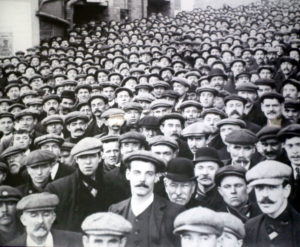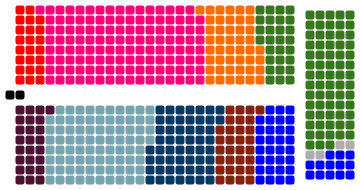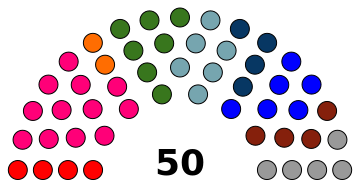1925 Kyotakavian general election
This article is incomplete because it is pending further input from participants, or it is a work-in-progress by one author. Please comment on this article's talk page to share your input, comments and questions. Note: To contribute to this article, you may need to seek help from the author(s) of this page. |
| ||||||||||||||||||||||||||||||||||||||||||||||||||||||||
All 535 seats to the Legislative Assembly 268 seats needed for a majority | ||||||||||||||||||||||||||||||||||||||||||||||||||||||||
|---|---|---|---|---|---|---|---|---|---|---|---|---|---|---|---|---|---|---|---|---|---|---|---|---|---|---|---|---|---|---|---|---|---|---|---|---|---|---|---|---|---|---|---|---|---|---|---|---|---|---|---|---|---|---|---|---|
| Turnout | 92.68% ( | |||||||||||||||||||||||||||||||||||||||||||||||||||||||
This lists parties that won seats. See the complete results below. | ||||||||||||||||||||||||||||||||||||||||||||||||||||||||
| ||||||||||||||||||||||||||||||||||||||||||||||||||||||||
Legislative Elections were held in the Svozgardan protectorate of Kyotakavia on the 1st January 1925 to elect all 535 representatives of the Kyotakavian Assembly, as well as 10 of the 30 State Ministers in the Kyotakavian State Ministerial Council. Kyotakavian Representatives are elected from 110 First Past the Post Constituencies, 400 Proportional Seats and 25 Svozgardan reserved seats whilst State Ministers are elected through an STV election in the state. To qualify for Proportional Seats, a party must reach 3.00% of the vote.
The result was a landslide 10.6 swing to the Kyotakavian United Syndicalist and Socialist Coalition. This swing came largely from the three traditional parties of government, the Workers' Party, Populists and the Traditionalists all who suffered catastrophic losses in seats though it is important to note that a large amount of the Syndicalist vote came from new voters who had not participated in the last few elections. Parties on the fringes of politics, specifically the KPK and the Front saw substantial increases in their vote share and more than doubled their representation in the Assembly. The NLP also saw a large upswing in support, restored to significant political position for the first time since the Second War of Kyotakavian Independence with the victory being especially significant for them as they made gains from the SLA in the ethnically divided cities of Nowa Grudak and Soborski.
The election was historical for several reasons, first as a result of the landslide victory of the Syndicalist Party under Johaan Calstaunas which saw the highest vote share and largest seat count ever won by a party at an election for the Legislative Assembly. The dramatic swing was also the largest of any election in the history of Kyotakavia, and confounded pre-election predictions that the Populists would retain enough seats to continue to govern with the arrival of a new party into government. Calstaunas was considered a major factor in the dramatic overturning of predictions, being a charismatic personality and passionate orator as well as having taken the Syndicalist Party in a comparatively more moderate direction meaning that a large number of voters, hitherto thought completely opposed to voting KUSSC, made the switch from centre-right to left-wing. The turnout for this election was also the highest seen, with nearly 93% of the nation voting, contributing to the strong electoral performance of fringe parties and the KUSSC. The Svozgardan Loyalist Alliance, for the first time either as themselves or as the King's Representation Committee, lost every seat they held except for the 25 reserved seats that they were assured under the Constitution.
Initially, little was expected in the form of dramatics during the government formation process as mathematically Alliance, the Workers' Party and KUSSC had 268 seats and were expected to govern with small concessions to the Independents in the Assembly. Political shockwaves were sent through the country however as the KUSSC instead chose to align with the NLP, the Do-or-Die nationalist party in the Assembly. The government therefore represented a political coalition of all the hardline-Nationalist parties, and after approval from all participants was confirmed on the 15 January 1925, the new, hardliner government was sworn in on a platform of strict and vocal opposition to the national Svozgardan government.
Background
The Populist-Traditionalist government of Stefan Kobovic had lead the national picture of Kyotakavia for a decade with two successive election wins for the parties of government though neither had been a majority and Kobovic had been reluctant to draw another, "less reliable" party into the government, especially as such a move would almost certain bring a more Nationalist party into the government and necessitate concessions on the reformist agenda. This however had left the Government reliant on the abstention of the SLA from none-constitutional issues and the Populists and Traditionalists had become increasingly unpopular, seen as "collaborators" with the Svozgardan government due to their reliance on the SLA.
The "collaboration" issue would turn out to be a major electoral hindrance however and the role that the Svozgardan Loyalist Alliance had played in enabling the continuation of Populist Government following the 1920 Kyotakavian general election tarnished the parties in Government and led to a resurfacing of ethnic tensions with them being their "highest since the first war" in the words of political analysis Stuzak Kotberji. Politically, the move was disastrous for the Populists who saw several senior defections over the course of the term as well as an increasingly vitriolic rhetoric against the party and its officials in both the press and the Legislative Assembly as well as the move pushing voters towards voting for the nationalist parties all of whom saw large increases in support as the term of the Assembly wore on.
Of the major nationalist parties, KUSSC, Alliance and the NLP had all undertaken significant Paramilitary mobilisation programs over the last five years in the face of a growing resentment, political division, and ethnic tension, especially the KUSSC-affiliated Union Guard which oversaw a 150% increase in manpower over just the years of 1922-1924. The NLP-Paramilitary, the KLA had also responded to the crisis of governance resulting from the SLA's support by not just increasing its manpower but also bolstering its armed activities, culminating in an increased volume of clashes between the KLA and the Svozgardan Armed Forces, totalling 27 confrontations, ambushes and skirmishes between 1923-1924, resulting in the death of 17 Kyotakavians and 28 Svozgardans. This had further contributed to a tense political climate that was building, especially as violence on the streets of Nowa Grudak between the KLA, Union Guard troops and Svozgardan Paramilitaries killed 58 in August 1924 alone. Indeed by November, the Svozgardan-run Protectorate Internal Security Force had lost control of the Mbersk Road, a dividing street between the Kyotakavian and Svozgardan communities, with paramilitary forces from both sides functionally running law and order in the area, making it a no-go zone for police officers.
Economically the situation had taken a turn for the worse since 1923 as a re-negotiated taxation arrangement with Svozgarda saw a total of 5% of GDP exported abroad or specifically invested into Svozgardan communities, necessitating a series of economic cuts to public services and an income tax increase in the 1924 budget which directly contributed to a significant decline in the quality of life for many working-class Kyotakavians, especially in Jepultipac and Nodstok. The Populist-led government at the time was attached to a policy of austerity in the face of increased contributions to Svozgarda which, combined with the closure of several mines in the "Coal Belt" in western Nodstok and north-eastern Uzgoyav, led to a general strike in mid-1924 that ground the majority of the country's industry to a halt, and was only broken with the bussing of Svozgardan Armed Forces into Kyotakavia at the behest of the government, to force workers back to their jobs. The strikers drew significant sympathy from the wider Kyotakavian public however, and KUSSC, representing the majority of affiliated trade unions in the country, saw a surge of support especially for several front bench members of the party who had been injured in the clashes (including Georgikov Alexi, Representative for Albaniv, the sole KUSSC representative from Nodstok, who was killed by Svozgardan armed forces).
In response to the General Strike, the Populist-led government drafted the 1924 Labour Restrictions Act. The Government was in a minority, however the SLA committed to abstention on the bill and the NLP were expected to follow as well, reducing the needed majority from 268, to 229, with 228 votes for confirmed between the Populists, Traditionalists and the Front, necessitating only an abstention or yes from an independent. KUSSC, the KPK, the Worker's Party, and Alliance all protested the bill and two demonstrations were held in front of the Assembly chamber, including on the day of the vote. Despite expectation that the bill would pass, the NLP surprised both the Government and Opposition in the chamber, voting against the bill, resulting in it's defeat; 253-230 with 52 abstentions.
Despite the disastrous political fallout resulting from the "collaboration" of the Populist-led government, there wasn't an expectation of a successful opposition result. Alliance were expected to take numerous seats, but predictions that KUSSC would be able to have a historically unprecedented swing were dismissed by most political analysts and senior leadership in both the Populist and Traditionalist parties. Up until the vote on the Labour Relations Act in October, KUSSC reliably polled at only around fifteen percent and Assembly business and polling wrapped up a week later at the start of the campaign period. The last poll of the term however, saw a KUSSC surge of four-points, placing them on around twenty percent as the Government vote share saw a substantial dip.
Campaigning
November Campaigning
With candidate declaration concluding the 31st October, campaigning began in earnest on the 1st November with the first visit from a party leader being Johaan Calstuanas in his own seat of Rezgernorsk at 07:21.
December Campaigning
Polling Day
On polling day KUSSC, Alliance and the NLP made substantial use of paramilitary forces to bus voters to nearby polling stations in order to ensure that as many people got out to vote as possible, there were some claims of intimidation and coercion though cases of this remained relatively low outside of Jepultipac and Nodstok. Indeed in Kyotakas, some constituency seats reached 90+ turnout on the back of hard work put in by Nationalist parties to turnout voters, and indications given suggested that a large number of these voters would turnout for parties other than those which brought them to the station. The end result in the three western states was a major uptick in turnout for the three major Nationalist parties as well as a significant shifting in the political demographics as voters changed from the Populists to more radical alternatives.
Polling stations were also brought into factories and mines in many western states, enabling workers to vote far more easily to the benefit of KUSSC who saw industrial town turnout increase by an average of 10-15 points this election, with large numbers of working-class people coming out in support of the party.
Jepultipac and Nodstok suffered heavily from polling day violence however, in stark contrast to their western counterparts, the ethnic divisions in several major cities spilled into open warfare and at least one polling station in the Svozgardan-side of Nowa Grudak were overrun by KLA militia and shut down, contributing to the loss of the constituency seats in the city. PISF were forced out of Kyotakavian polling stations and a gun battle erupted outside of Precinct 12 Headquarters on Mtelsk Street between the KLA and PISF Officers.
Results
| Party | Votes | % | Proportional | Constituency | Total | ||||||
|---|---|---|---|---|---|---|---|---|---|---|---|
| Seats | Seats | Seats | ± | ||||||||
| KUSSC | 5,542,172 | 24.97% (+13.54) | 101 | 27 | 128 | +69 | |||||
| Alliance | 4,299,006 | 19.37% (+4.08) | 78 | 19 | 97 | +20 | |||||
| Populists | 3,496,820 | 15.75% (-7.62) | 65 | 18 | 83 | -40 | |||||
| Traditionalists | 2,158,366 | 9.72% (-9.17) | 41 | 13 | 54 | -45 | |||||
| Workers' Party | 2,196,038 | 9.89% (-7.08) | 41 | 4 | 45 | -39 | |||||
| NLP | 2,034,271 | 9.16% (+4.25) | 38 | 7 | 45 | +19 | |||||
| The Front | 963,952 | 4.34% (+2.30) | 19 | 12 | 31 | +25 | |||||
| SLA | 620,475 | 2.80% (-1.66) | 25 | 0 | 25 | -26 | |||||
| KPK | 886,393 | 3.99% (+1.36) | 17 | 6 | 23 | +19 | |||||
| Independents | N/A | N/A | 0 | 4 | 4 | -2 | |||||
| Party | State Ministers | State Presidents | Results | ||||||||
|---|---|---|---|---|---|---|---|---|---|---|---|
| Seats | Seats | Ministers ± | Presidents ± | ||||||||
| KUSSC | 12 / 50 |
2 / 5 |
+4 | +1 | |||||||
| Alliance | 7 / 50 |
1 / 5 |
+2 | +1 | |||||||
| Populists | 6 / 50 |
1 / 5 |
-4 | -1 | |||||||
| NLP | 6 / 50 |
1 / 5 |
+1 | +1 | |||||||
| Independents | 5 / 50 |
0 / 5 |
-1 | -1 | |||||||
| Traditionalists | 4 / 50 |
0 / 5 |
-1 | -1 | |||||||
| The Front | 4 / 50 |
0 / 5 |
+1 | ||||||||
| KPK | 4 / 50 |
0 / 5 |
|||||||||
| Workers' Party | 2 / 50 |
0 / 5 |
-1 | ||||||||
| SLA | 0 / 30 |
0 / 5 |
-1 | ||||||||



